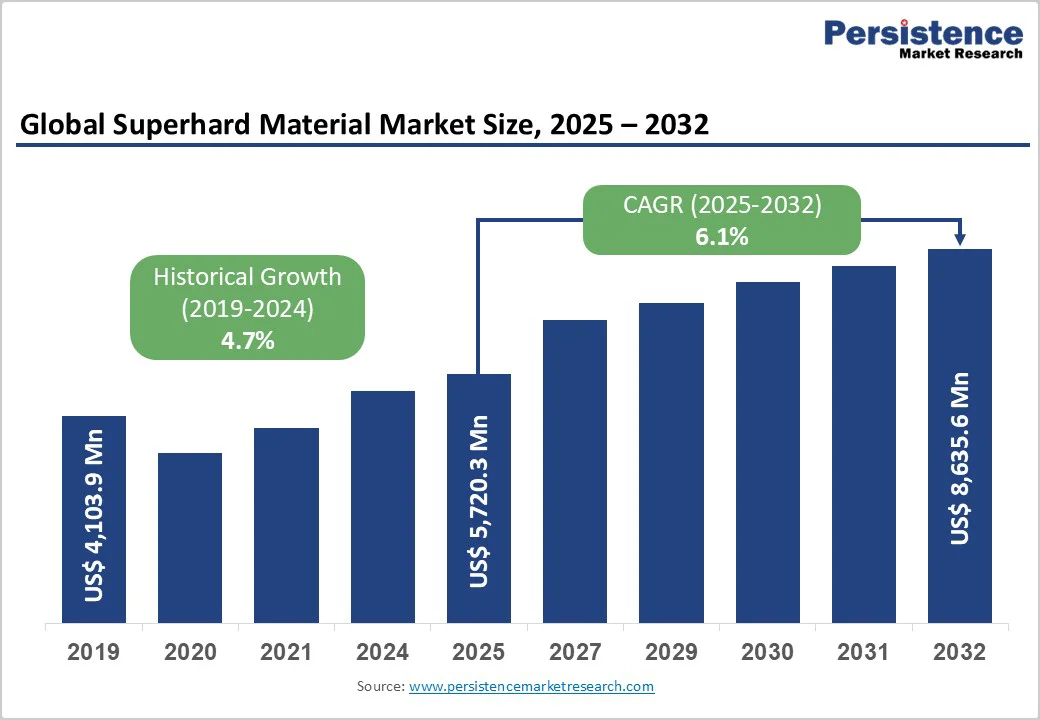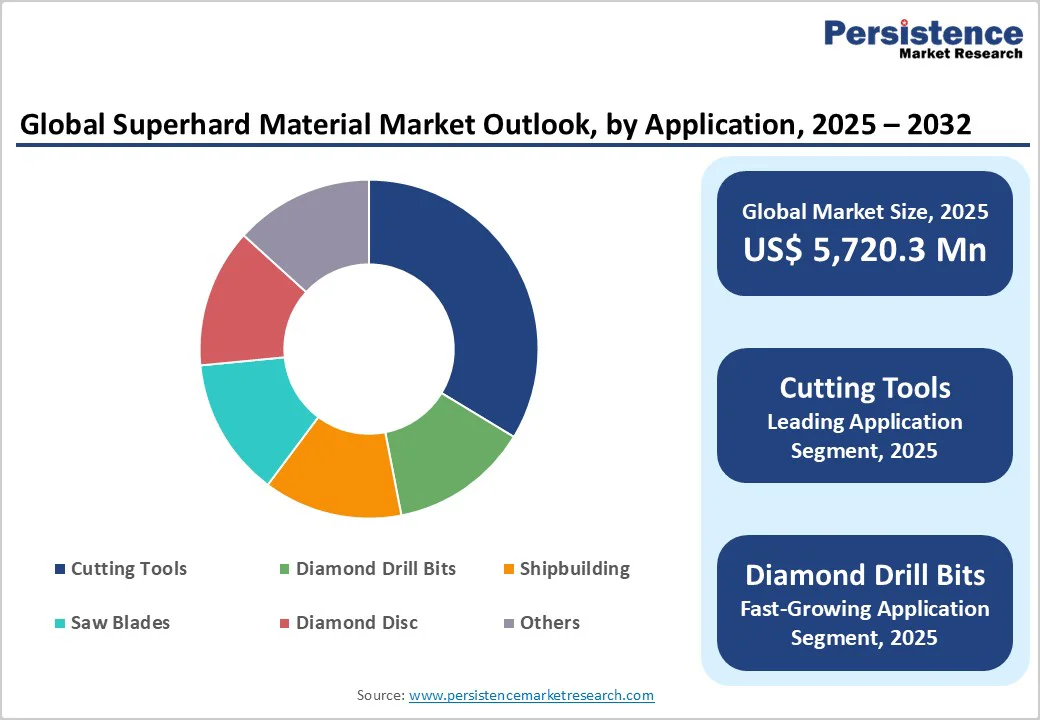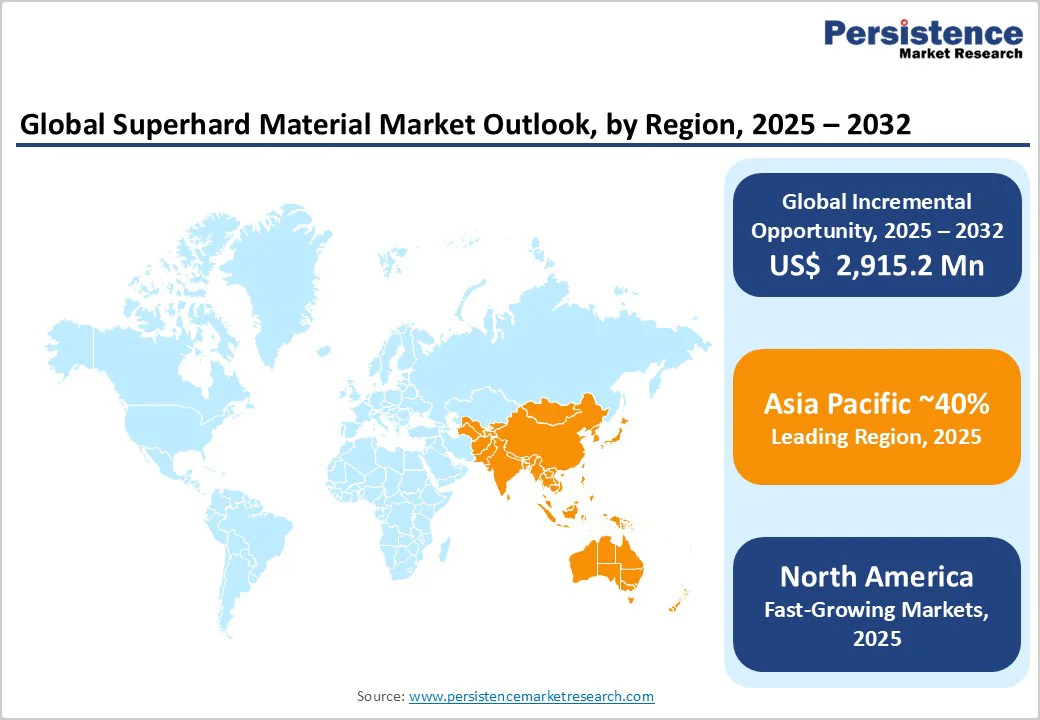ID: PMRREP3646| 200 Pages | 17 Nov 2025 | Format: PDF, Excel, PPT* | Chemicals and Materials

The global superhard material market is valued at US$ 5,720.3 million in 2025, and is expected to reach US$ 8,635.5 million, growing at a CAGR of 6.1% between 2025 and 2032. This trajectory reflects growing demand from automotive, aerospace, construction, and manufacturing sectors, where precision cutting, grinding, and drilling operations require materials with exceptional hardness exceeding 40 gigapascals.
Superhard materials are characterized by hardness levels exceeding 40 GPa, making them exceptionally resistant to deformation and wear. Diamond, with a hardness of approximately 90 GPa, ranks as the hardest known material, followed by cubic boron nitride (cBN), which exhibits a hardness of around 50 GPa.
| Key Insights | Details |
|---|---|
|
Superhard Material Market Size (2025E) |
US$ 1,278.5 Mn |
|
Market Value Forecast (2032F) |
US$ 2,405.3 Mn |
|
Projected Growth (CAGR 2025 to 2032) |
9.4% |
|
Historical Market Growth (CAGR 2019 to 2024) |
8.1% |

The automotive and aerospace industries represent critical growth engines for the superhard materials market, with automotive applications alone commanding over 35% of end-user market share. The global automotive sector's transition toward electric vehicles and lightweight component manufacturing has intensified demand for polycrystalline diamond (PCD) and cubic boron nitride (CBN) cutting tools capable of precision machining aluminum alloys, titanium, and composite materials.
According to industry data, the aerospace cutting tools market is expanding at 8.4% CAGR, driven by next-generation aircraft production requiring superhard tools for machining advanced alloys and carbon fiber composites. The automotive industry's focus on fuel efficiency and emission reduction has accelerated adoption of superhard materials for processing hardened steels and cast iron components, where CBN tools demonstrate 3-5 times longer tool life compared to traditional carbide alternatives. Manufacturing automation and Industry 4.0 integration further propel demand, as precision engineering requirements necessitate tools delivering tighter tolerances and superior surface finishes
Superhard material technology is transforming modern manufacturing through precise force control, reduced energy use, and adaptive capabilities aligned with Industry 4.0. Supported by initiatives such as the U.S. Department of Energy’s Advanced Manufacturing Office and Japan’s “Connected Industries,” servomotor-driven equipment adoption is accelerating globally. Research from ISO and IEC underscores their advantages in accuracy, speed, and shorter cycle times, fostering widespread adoption across industries.
The rise in local and foreign direct investments in manufacturing particularly in automotive and electronics sectors across Asia Pacific and North America are fueling large-scale plant expansions. Reports by UNCTAD and Invest India highlight multi-billion-dollar inflows into precision stamping and sheet-forming facilities, positioning superhard materials as key productivity enablers for high-volume, high-quality production environments.
The superhard materials industry faces notable challenges that hinder wider adoption and cost efficiency. Production of synthetic diamond and cubic boron nitride (CBN) involves high-pressure, high-temperature (HPHT) processes exceeding 5 GPa and 1,500°C, demanding advanced equipment and resulting in high capital and operational costs. Price volatility of raw materials such as cobalt binders for PCD and catalytic metals for diamond synthesis further creates pricing instability, limiting competitiveness in cost-sensitive applications. Additionally, strict environmental regulations governing emissions and hazardous waste management increase compliance costs, pushing manufacturers to adopt sustainable production technologies.
Beyond cost factors, material limitations restrict application scope. Diamonds lose thermal stability above 800°C and react chemically with ferrous materials, necessitating the use of CBN for steel and iron machining. Their inherent brittleness makes them prone to chipping in high-impact operations, reducing suitability for interrupted cutting tasks. Moreover, limited technical expertise and supply chain constraints in developing regions further impede market expansion. Together, these factors emphasize the industry’s need for innovation in synthesis methods, durability enhancement, and sustainable manufacturing practices.
The electronics and semiconductor industries present substantial growth opportunities, with cubic boron nitride's ultra-wide bandgap properties enabling applications in high-power electronics and ultraviolet optoelectronics. CBN's superior thermal conductivity and electrical insulation characteristics make it increasingly valuable for semiconductor fabrication, thermal management substrates, and precision machining of silicon wafers. The global electronics market's 6% CAGR supports expanding CBN utilization in device manufacturing requiring exceptional thermal dissipation and chemical inertness.
Superhard material coatings for cutting tools used in processing printed circuit boards, ceramic components, and glass substrates for display technologies offer differentiation opportunities for manufacturers targeting high-precision electronics applications. The miniaturization trend in consumer electronics and telecommunications equipment demands ultra-precision machining capabilities achievable only through advanced superhard tooling, creating niche markets with premium pricing potential.
Extrinsic Materials Lead Market Share, While Intrinsic Segment Emerges as the Fastest-Growing Category
The extrinsic superhard materials segment dominates the global market, accounting for over 60% of total revenue, driven by strong demand for engineered composites whose exceptional hardness results from microstructural design rather than inherent composition. Materials such as polycrystalline diamond (PCD) and polycrystalline cubic boron nitride (PcBN) are produced through advanced sintering techniques that yield dense, uniform structures with precisely controlled grain sizes. These features optimize hardness, toughness, and wear resistance for critical industrial applications such as cutting, drilling, and grinding. Extrinsic materials also provide consistent quality, scalability, and cost advantages over natural superhard materials while maintaining comparable or superior performance in high-stress environments.
In contrast, the intrinsic superhard materials segment, though smaller in market share, is the fastest-growing category, propelled by breakthroughs in synthesis technologies and growing demand from specialized precision machining sectors. Intrinsic compounds such as single-crystal diamond and cubic boron nitride offer unmatched crystalline hardness and are vital for applications requiring mirror-smooth finishes and sub-micron dimensional accuracy. Ongoing research into advanced materials like boron carbide, carbon nitrides, and B–N–C ternary compounds is expanding this segment’s potential, aiming to surpass natural diamond in hardness while improving thermal stability and minimizing chemical reactivity with ferrous metals.
Polycrystalline Diamond (PCD) Leads the Market, While PCBN Emerges as the Fastest-Growing Segment
The Polycrystalline Diamond (PCD) segment dominates the market with over 30% share, attributed to its exceptional wear resistance, hardness, and thermal conductivity, making it indispensable for machining non-ferrous metals, composites, and abrasive materials. Produced through high-pressure sintering of diamond particles with a tungsten carbide substrate, PCD tools achieve hardness levels approaching 7,500 Vickers, ensuring extended tool life and superior surface finish in demanding applications.
The automotive and aerospace industries are major end users, employing PCD tools for machining engine components, structural parts, and composite assemblies. Additionally, their use is expanding into woodworking applications, particularly in engineered lumber and laminated flooring production, reinforcing PCD’s market leadership.
Polycrystalline Cubic Boron Nitride (PCBN) represents the fastest-growing segment, driven by its ability to machine hardened ferrous metals where diamond tools are unsuitable. PCBN’s chemical stability and high thermal resistance enable efficient cutting of hardened steels, cast irons, and nickel-based superalloys at elevated speeds without compromising tool integrity. Rising demand from automotive and aerospace manufacturing, where durability and precision are critical, supports a robust 10.5% CAGR. Continuous innovation in CBN content formulations, balancing chemical wear and abrasion resistance further strengthens PCBN’s adoption for both continuous and interrupted machining operations across advanced manufacturing sectors.
Polycrystalline Dominance and Composite Innovation Driving Superhard Material Form Advancements
The polycrystalline form leads the market with over 45% share, owing to its versatility across cutting, grinding, and drilling applications. Its random crystal orientation eliminates the directional weaknesses typical of single-crystal structures, providing isotropic mechanical strength and uniform performance in all cutting directions. Polycrystalline diamond (PCD) and cubic boron nitride (CBN) compacts, when integrated with cemented carbide substrates, deliver an optimal combination of hardness, toughness, and thermal resistance—making them ideal for demanding machining environments in automotive, aerospace, and tooling industries.
Composite forms are the fastest-growing segment, driven by advancements in multi-material engineering and nano-additive technology. These composites feature graded compositions, refined binder systems, and functionally tailored microstructures that enhance impact resistance, thermal stability, and chemical durability. Ongoing innovations in diamond-metal composites and hybrid architectures are enabling next-generation tools optimized for emerging sectors such as additive manufacturing, advanced ceramics processing, and aerospace component machining, where precision, reliability, and durability are critical.

Asia Pacific holds over 40% of the global superhard materials market, establishing itself as the dominant production and consumption hub. The region’s leadership is anchored by China, the world’s largest synthetic diamond producer, with major players such as Zhongnan Diamond and Henan Huanghe Whirlwind operating large-scale facilities that supply both domestic and export markets. Regional growth is fueled by rapid urbanization, infrastructure expansion, and robust manufacturing activity in automotive, electronics, and construction sectors.
India is emerging as a high-growth market, supported by pro-manufacturing government policies and increasing foreign investment in industrial sectors. Meanwhile, Japan’s precision engineering expertise sustains strong demand for advanced cutting tools and abrasives, while Southeast Asian nations such as Thailand, Indonesia, and Vietnam continue to attract manufacturing investments, driving derivative demand for superhard tooling and industrial applications. Regional advantages, including cost-competitive production, expanding skilled labor pools, and proximity to key end-user industries, position Asia Pacific for continued market dominance through 2032.
North America represents a mature yet rapidly advancing market, distinguished by technological innovation, stringent quality standards, and a strong presence of aerospace and advanced manufacturing industries. The United States leads regional demand, supported by established players such as Element Six, Hyperion Materials & Technologies, and specialized tool manufacturers serving the automotive, aerospace, oil and gas, and precision machining sectors. The region is witnessing the fastest growth among developed markets, fueled by reshoring initiatives, domestic oil and gas exploration, and the ongoing recovery of the aerospace industry.
A robust regulatory framework emphasizing worker safety and environmental compliance continues to drive the adoption of advanced, eco-efficient superhard tools that enhance productivity while minimizing waste. North American manufacturers are heavily investing in R&D to develop next-generation cutting geometries, high-performance coatings, and application-specific designs. With a sophisticated distribution network, strong technical support, and growing automation integration, the region is well-positioned for sustained growth in high-value industries such as aerospace, medical devices, and energy applications.

The global superhard materials market is moderately concentrated, with established international players and several regional manufacturers competing across applications and geographies. Market leaders such as Element Six (Luxembourg), a De Beers Group subsidiary, maintain a strong position through extensive synthetic diamond and CBN portfolios catering to cutting, drilling, abrasive, and advanced technology applications. The company operates across the U.K., Ireland, Germany, South Africa, and the U.S., leveraging deep R&D capabilities and vertical integration from synthesis to finished tool production.
Industry leaders emphasize innovation-driven differentiation, investing in advanced manufacturing technologies, materials science, and customized solutions. Vertical integration ensures material quality, supply chain stability, and cost competitiveness, while geographic expansion through localized production and distribution strengthens responsiveness in emerging markets. Sustainability and digitalization are central to strategy, with manufacturers adopting eco-friendly synthesis, tool recycling, and Industry 4.0-enabled predictive maintenance to enhance efficiency and deliver lifecycle value beyond initial tool cost.
The Superhard Material market is estimated to be valued at US$ 1,278.5 Mn in 2025.
The key demand driver for the superhard materials market is the rising demand for high-precision machining and wear-resistant tooling across industrial sectors such as automotive, electronics, aerospace, and construction
In 2025, the Asia Pacific region will dominate the market with an exceeding 40% revenue share in the global superhard material market.
Among covers, Polycrystalline Diamond (PCD) holds the highest preference, capturing beyond 30% of the market revenue share in 2025, surpassing other covers.
Sandvik Element Six, Zhongnan Diamond, JINQU Superhard, Huanghe Whirlwind, and Zhengzhou Zhong Peng are a few leading players.
| Report Attribute | Details |
|---|---|
|
Historical Data/Actuals |
2019 - 2024 |
|
Forecast Period |
2025 - 2032 |
|
Market Analysis Units |
Value: US$ Mn |
|
Geographical Coverage |
|
|
Segmental Coverage |
|
|
Competitive Analysis |
|
|
Report Highlights |
|
By Product Type
By Type
By Cover
By Form
By Application
By End User
By Region
Delivery Timelines
For more information on this report and its delivery timelines please get in touch with our sales team.
About Author